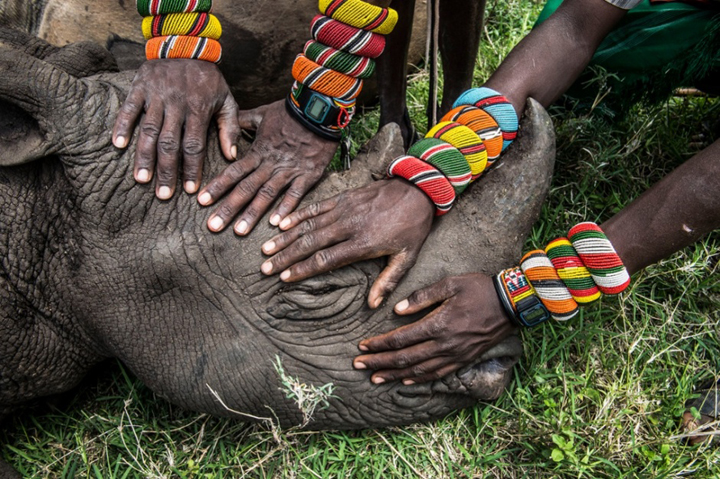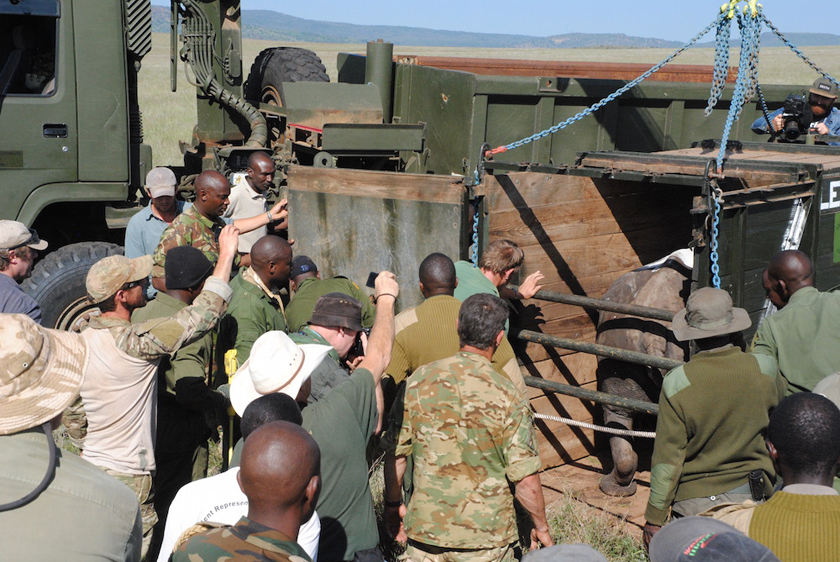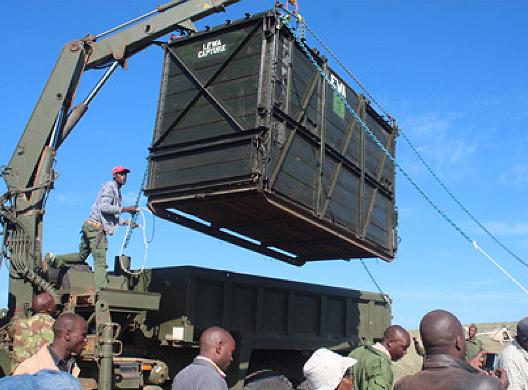A Kenyan Community Helps Rhinos Come Home
The arduous 10-day effort to translocate 20 critically endangered rhinos to former rangelands in Northern Kenya is in high gear this week.
By Vicki Croke

Samburu warriors got to touch a rhino for the first time in their lives. In fact, they had never even seen a photo of one. They came to Lewa Wildlife Conservancy to learn about protecting these animals in advance of this week’s translocation of 20 rhinos. This photo, by Ami Vitale, won second prize in the nature category of the 2015 World Press Photo Contest, which has now been collected in a book.
Earlier this year, a photograph of Samburu warriors in Kenya touching a rhino calf for the first time in their lives won a World Press Photo award. There was sadness to the story of Kalifi the rhino—his mother had been killed by poachers—and there was sadness in the warriors’ story too—they had grown up in a once rhino-rich land that now held none.
But the inherent hope expressed in that photo—for new life and reconnection—is being realized this week. A huge and arduous 10-day effort is underway across miles of bumpy and remote roads to translocate 20 critically endangered Eastern black rhinos to lands in Samburu county in Northern Kenya that have been without the species for 25 years.

The first black rhino, a female, is loaded into the translocation box. Courtesy of Northern Ranglands Trust.
And the hands that are captured patting Kalifi in that iconic photo will now be helping to protect the rhinos in their new turf.
It’s taken the will and commitment of a local community, several conservation organizations, three national parks, a council of elders, 20 satellite transmitters (one per animal), anti-poaching training for local rangers, to tick off a few components, to bring these magnificent rhinos, ranging in age from six to 20, to a place where the residents are banding together to receive and protect them.
The sanctuary receiving the animals, Sera Community Conservancy, is community owned and operated.
There are four black rhinos on the ground now, and 16 more to come over the next eight days, according to Ginger Thomson of the Lewa Wildlife Conservancy. The rhinos are tranquilized before making the trip of several hours over rough roads in giant crates fitted on the back of trucks.
The effort—a public-private collaboration of three conservation organizations, the Kenya Wildlife Service, the Northern Rangelands Trust, and Lewa Wildlife Conservancy, pooling rhinos from three different reserves (Lewa Conservancy, Nairobi and Nakuru National Parks) marks an important passage for rhino conservation in Kenya, according to those involved.
[youtube=http://youtu.be/rUHxVvw2LLo]
In 2011, a group of 19 critically endangered black rhinos were moved within South Africa to new habitat established by the WWF’s Black Rhino Range Expansion Project. Video courtesy of Green Renaissance and WWF-South Africa.
Lewa Wildlife Conservancy, a conservation organization, which manages some 100,000 acres of rhino rangeland, and is one of the participants in this translocation, released a statement about the significance of the effort:
This will be the first time in East Africa a local community will be responsible for the protection and management of the highly threatened black rhino, signaling a mind shift in Kenya’s conservation efforts. This pioneering move demonstrates the Government of Kenya’s confidence in the local community, and materialises the promise to support community-based conservation initiatives as provided for by the new Wildlife Act, 2013.
It is expected that the presence of black rhino in Samburu County will be a significant boost to tourism in the area whilst providing new job opportunities for local communities. Parts of the Sanctuary will also be set aside for dry season grazing for local herders, and the community look forward to increased overall security in the area.
Mostly because of poaching and hunting, the Eastern black rhino population fell by 98 percent in just three decades, between 1960 and 1990. In the 1970s, there were 20,000 in Kenya. At the tail end of that period, there were only 381 there. Today, there are 640 in closely-guarded parks and sanctuaries. The translocation of 20 healthy rhinos to Samburu is part of the effort to expand rhino habitat in Kenya and boost the population.

Lewa Wildlife Conservancy Chief Security Officer John Pameri and baby rhino Kilifi. Courtesy of Lewa Wildlife Conservancy and Paula Kahumbu.
The return of the rhinos is the culmination of years of effort. According to the Northern Rangelands Trust website:
Like many other conservancies in the area that would have once supported free roaming black rhino, Sera’s history is tainted with heavy poaching, tribal conflict, cattle rustling and road banditry. With support from USAID, Sera became an NRT member conservancy in 2001. Since then, the communities of Sera have spearheaded peace talks with neighbours and started to implement strict grazing management programmes.
Rangers, employed from the local community, conduct regular anti-poaching patrols and wildlife monitoring. The effect this has had on securing peace in the area, and stabilising wildlife populations has been so significant, that in 2007 talks began on establishing a protected area for black rhino in Sera’s 3,450 square kilometres. With the backing of the Sera Conservancy Board, KWS carried out habitat, veterinary and security assessments in 2009 and 2010, and a 120 square kilometre area was designated for a fenced sanctuary.
*UPDATE: As of May 28, the rhino relocation project has been suspended for six months because of the deaths of three translocated rhinos. Thirteen rhinos had been moved at the time of the suspension. A dispatch from Lewa Conservancy provides some details:
“On Monday (May 25, 2015) the post-translocation monitoring team reported the death of two rhinos that had been captured from Lewa and released in Sera Conservancy on May 18 and 19 2015. Postmortem by our veterinary team revealed the two rhino’s succumbed to complications arising from impaction in the lower gut. The third one succumbed to anesthetic complications during capture of at Lewa and efforts to resuscitate it did not bear fruit.A team of veterinarians has been put on standby to undertake clinical monitoring of the remaining eleven (11) translocated rhinos and to investigate the risk factors at Sera Conservancy that could have led to the two mortalities.”
WBUR’s The Wild Life will continue to update this story.


2 Responses to “A Kenyan Community Helps Rhinos Come Home”
Congratulations! Thank you from the bottom of the hearts of all compassionate people all across the Earth! Phenomenal focus, mission, effort and success! This will be the model for the rest of the great continent of Africa!
Congrats to all the community members who are and will be working to protect the rhino population in south Africa. You are so important and the world thanks you for your dedication.
Comments are closed.